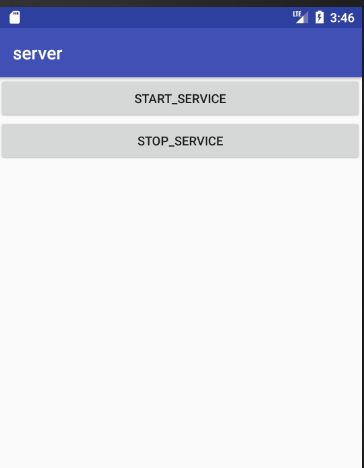定义一个服务
-
新建一个项目,右击com.example.servicetest --> New --> Service -->Service,会弹出一个窗口,如下所示:
- 可以看到这个服务的名字为MyService,Exported表示是否允许除了当前程序之外的其他程序访问这个服务,Enabled属性表示是否启用这个服务,建立完成后可以看到
public class MyService extends Service {
public MyService() {
}
@Override
public IBinder onBind(Intent intent) {
// TODO: Return the communication channel to the service.
throw new UnsupportedOperationException("Not yet implemented");
}
}
- 自定义的MyService是继承子Service,这里面只有一个onBind()方法,这个方法是Service中唯一一个抽象的方法,所以在子类中必须实现,以后会用到的
- 这个时候Service中还是空空如也,所以就得重写Service中的另外一些方法了,如下所示:
public class MyService extends Service {
public MyService() {
}
@Override
public void onCreate() {
super.onCreate();
}
@Override
public int onStartCommand(Intent intent, int flags, int startId) {
return super.onStartCommand(intent, flags, startId);
}
@Override
public void onDestroy() {
super.onDestroy();
}
@Override
public IBinder onBind(Intent intent) {
// TODO: Return the communication channel to the service.
throw new UnsupportedOperationException("Not yet implemented");
}
}
- 可以看到这里重写了3个方法,
- onCreate()在服务创建的时候调用,
- onStartCommand()会在每次服务启动的时候调用,
- onDestroy()会在服务销毁的时候调用
- 通常情况下,如果希望服务一旦启动就立刻去执行某个动作,就可以将逻辑写在onStartCommand()方法中,当服务销毁的时候,就可以在onDestroy()方法中回收那些不用的资源
- 要注意的是每一个服务要在AndroidManifest.xml文件中进行注册,但是android Studio已经帮我们注册好了
...
- 一个服务就这样定义好了
启动和停止服务
启动和停止一个服务还要借助Intent来实现,在项目中实战一下
- 修改activity_main.xml中的代码
- 添加两个按钮,一个用来启动服务,一个用来停止服务
- 修改MainActivity中的代码
public class MainActivity extends AppCompatActivity implements View.OnClickListener {
@Override
protected void onCreate(Bundle savedInstanceState) {
super.onCreate(savedInstanceState);
setContentView(R.layout.activity_main);
Button start_Service = (Button)findViewById(R.id.start_Service);
Button stop_Service = (Button)findViewById(R.id.stop_Service);
start_Service.setOnClickListener(this);
stop_Service.setOnClickListener(this);
}
@Override
public void onClick(View view) {
switch (view.getId()){
case R.id.start_Service:
Intent startIntent = new Intent(this,MyService.class);
// 启动服务
startService(startIntent);
break;
case R.id.stop_Service:
Intent stopIntent = new Intent(this,MyService.class);
// 停止服务
stopService(stopIntent);
break;
default:
break;
}
}
}
首先获取到了两个按钮的实例,并且绑定了点击事件
在点击事件中,
首先构建了一个Intent对象,里面传入自定义的服务,并调用这个startService()来启动服务,和调用stopService()方法停止停止这个服务startService()和stopService()方法都是定义在COntext类中的,所以就可以直接调用这两个方法
注意,这里完全是由活动来决定服务何时停止的,如果没有点击这个stop_service按钮,服务就会一直处于运行状态,这个时候怎么让服务停止呢,只要在MyService的任何一个位置调用stopSelf()方法就可以让这个服务停止了
- 怎么才能证实服务启动了呢,这个时候只要在MyService的方法中添加打印日志就可以了,如下
public class MyService extends Service {
public MyService() {
}
@Override
public void onCreate() {
super.onCreate();
Log.d("MyService","onCreate executed");
}
@Override
public int onStartCommand(Intent intent, int flags, int startId) {
Log.d("MyService","onStartCommand executed");
return super.onStartCommand(intent, flags, startId);
}
@Override
public void onDestroy() {
super.onDestroy();
Log.d("MyService","onDestroy executed");
}
@Override
public IBinder onBind(Intent intent) {
// TODO: Return the communication channel to the service.
throw new UnsupportedOperationException("Not yet implemented");
}
}
-
运行程序,
-
点击Start Service按钮就可以看到打印日志
-
点击设置-->开发者选项--> 正在运行的服务 就可以看到了
-
然后点击Stop Servire按钮,看打印日志
此时这个服务就停止了
- 这里要注意的是onCreate()和onStartCommand()方法,
onCreate()是在服务第一次创建的时候调用的,而onStartCommand()则在每次启动服务的时候就会调用的,第一次执行两个方法都会执行,之后再点击start Service按钮,只有onStartCommand()方法会得到执行
服务和活动进行通信
虽然服务是在活动里的,但是启动服务后,活动于服务基本就没有什么关系了,因为服务里的方法得到执行,之后服务就会一直处于运行的状态,但是具体运行逻辑的时候,活动控制不了服务了,有没有办法让活动这服务关联起来?就是在活动中指挥服务,让服务干什么,服务就干什么,这个时候就得借助onBind()方法了
- 比如希望在MyService里提供一个下载功能,在活动中可以决定何时开始下载,以及随时查看下载进度,实现这个功能的思路就是创建一个专门的Binder对象来对下载功能进行管理,修改MyService中的代码
public class MyService extends Service {
private DownloadBinder mBinder = new DownloadBinder();
class DownloadBinder extends Binder{
public void startDownload(){
Log.d("MyService","startDownload executed");
}
public int getProgress(){
Log.d("MyService","getProgress executed");
return 0;
}
}
...
@Override
public IBinder onBind(Intent intent) {
return mBinder;
}
}
- 这个时候新建一个DownloadBinder类继承自Binder,然后在它的内部提供了开始下载以及查看下载的方法,当然这只是一个模拟方法,分别打印日志
- 然后在MyService中创建一个DownloadBinder的实例,然后在onBind()方法中将这个实例返回
- 在活动中如何调用服务里的这些方法,首先在布局文件中新增两个按钮,修改activity.xml中的代码
...
- 这两个按钮分别用于绑定服务和取消绑定服务,
- 当一个活动和服务绑定了之后,就可以调用该服务中的Bunder提供的方法,修改MainActivity中的代码
public class MainActivity extends AppCompatActivity implements View.OnClickListener {
private MyService.DownloadBinder downloadBinder;
// 创建一个匿名类
private ServiceConnection connection = new ServiceConnection() {
// 绑定成功调用
@Override
public void onServiceConnected(ComponentName componentName, IBinder iBinder) {
//通过向下转型得到了DownloadBinder的实例
downloadBinder = (MyService.DownloadBinder) iBinder;
// 调用方法
downloadBinder.startDownload();
downloadBinder.getProgress();
}
// 解除绑定调用
@Override
public void onServiceDisconnected(ComponentName componentName) {
}
};
@Override
protected void onCreate(Bundle savedInstanceState) {
super.onCreate(savedInstanceState);
setContentView(R.layout.activity_main);
Button start_Service = (Button)findViewById(R.id.start_Service);
Button stop_Service = (Button)findViewById(R.id.stop_Service);
start_Service.setOnClickListener(this);
stop_Service.setOnClickListener(this);
Button bind_Service = (Button)findViewById(R.id.bind_Service);
Button unbind_Service = (Button)findViewById(R.id.unbind_Service);
bind_Service.setOnClickListener(this);
unbind_Service.setOnClickListener(this);
}
@Override
public void onClick(View view) {
switch (view.getId()){
case R.id.start_Service:
Intent startIntent = new Intent(this,MyService.class);
// 启动服务
startService(startIntent);
break;
case R.id.stop_Service:
Intent stopIntent = new Intent(this,MyService.class);
// 停止服务
stopService(stopIntent);
break;
case R.id.bind_Service:
Intent bindIntent = new Intent(this,MyService.class);
// 绑定服务,第二个参数是前面创建ServiceConnection的实例
bindService(bindIntent,connection,BIND_AUTO_CREATE)
break;
case R.id.unbind_Service:
// 解除绑定
unbindService(connection);
break;
default:
break;
}
}
}
首先创建一个ServiceConnection匿名类,这个类中重写onServiceConnected()和onServiceDisconnected()方法,这两个方法分别用于活动与服务成功绑定和解除绑定的时候调用,在onServiceConnected()方法中,通过向下转型得到了 DownloadBinder的实例,通过这个实例,就可以调用 DownloadBinder中的任何方法了当然了,这只是基础工作,真正的绑定是在点击按钮的时候,首先构建一个Intent对象然后调用bindService()方法,第一个参数是Intent对象,第二个参数是前面创建ServiceConnection的实例,第三个参数是一个标志位,BIND_AUTO_CREATE表示在活动和服务进行绑定后自动创建活动,这个时候就会使得MyService中的onCreate()方法得到执行,但是onStartCommand()方法不会执行解除绑定只要调用unbindService()方法就可以,传入的参数也是前面创建ServiceConnection的实例-
运行程序,就可以看到
点击这个Bind Service按钮,看打印日志
可以看到,onCreate()方法先得到执行,然后调用的方法也得到了执行 - 注意:任何一个服务在整个应用程序范围内都是通用的,即MyService不仅可以和MainActivity绑定,还可以和任何一个其他活动进行绑定,而且在绑定完成后他们都可以获取到相同的DownloadBinder实例
活动的生命周期
- 一旦在项目中的任何位置调用了Context的startServive()方法,相应的服务就会得到执行,并且回调onStartCommand()方法,如果服务第一次创建,那么onCreate()方法就会先于onStartCommand()方法执行,
- 服务启动了就会一直保持运行状态,直到stopService()或者是stopSelf()方法被调用,
注意虽然每一次都是调用startServive()方法,但是每个服务都只会存在一个实例,只要调用一次stopService()或者是stopSelf()方法,服务就会停止下来 - 另外,还可以调用Context的bindService()来获取一个服务的持久连接,这时就会回调服务中的onBind()方法,这时,如果服务第一次创建,那么onCreate()方法就会先于onBind()方法执行,之后就可以获取到onBind()方法里返回的IBinder对象实例,这样就能自由的和服务进行通信,只要调用方和服务之间的连接没有断开,服务就会一直保持运行状态
- 当调用startService()方法之后,又去调用stopService()方法,这是服务中的onDestroy()方法就会得到执行,这个时候服务就销毁了,类似的,当调用了bindService()方法之后,调用了unbindService()方法,服务中的onDestroy()方法就会得到执行,这个时候服务就销毁了
要注意的是,对一个服务调用了startService(),又调用了bindService()方法之后,这个时候要调用stopService()和unbindService()方法,onDestroy()方法才会执行
服务的更多技巧
使用前台服务
服务一般都是在后台运行的,当系统出现内存不足的时候,就有可能回收掉正在后台运行的服务,如果想要服务一直保持运行状态,而不会由于系统内存不足的原因导致被回收,就可以考虑使用前台服务了
- 前台服务与普通服务最大的区别就是它会一直有一个正在运行的图标在系统的状态栏显示,下拉可以看到更加详细的信息,比如说天气预报这种应用,一般都会在系统栏一直显示当前的天气
- 创建一个前台的服务,修改MyService中的代码
public class MyService extends Service {
...
@Override
public void onCreate() {
super.onCreate();
Log.d("MyService","onCreate executed");
Intent intent = new Intent(this,MainActivity.class);
PendingIntent p1 = PendingIntent.getActivity(this,0,intent,0);
Notification notification = new NotificationCompat.Builder(this)
.setContentText("this is title")
.setContentText("thsi is content text")
.setWhen(System.currentTimeMillis())
.setSmallIcon(R.mipmap.ic_launcher)
.setLargeIcon(BitmapFactory.decodeResource(getResources(),R.mipmap.ic_launcher))
.setContentIntent(p1)
.build();
// 这里与之前不同
startForeground(1,notification);
}
...
}
- 别的还保持不变,只需要修改onCreate()方法里的代码就可以了,这些代码就是之前学过的创建通知的方法
- 只不过这里没有使用 NotificationManager来将通知显示出来,而是使用了 startForeground()方法,类似与notity()方法,第一个参数是通知id,第二个参数是构建的Notification对象,调用这个startForeground()方法就会让MyService变成一个前台服务,并在系统状态栏显示出来
-
重新运行程序,点击Start Service按钮,MyService就会以前台的模式启动了,并且在系统状态栏会显示一个通知的图标,下拉状态栏就可以看到该通知的详细内容
使用IntentService
服务中的代码都是默认运行在主线程当中的,如果直接在服务中处理一些耗时的逻辑,就容易出现ANR的情况,所以这个时候就使用到了Android多线程编程技术了
- 我们应该在服务的每个具体的方法里开启一个子线程,然后在这里去处理一些耗时的逻辑,因此一个比较标准的服务就可以写成
@Override
public int onStartCommand(Intent intent, int flags, int startId) {
new Thread(new Runnable() {
@Override
public void run() {
// 处理具体的逻辑
}
}).start();
return super.onStartCommand(intent, flags, startId);
}
- 但是这种服务一旦启动就会一直处于运行的状态,必须调用stopService()或者stopSelf()方法才能让服务停止下来,所以想要实现让一个服务在执行完毕后自动停止下来就可以这样写
@Override
public int onStartCommand(Intent intent, int flags, int startId) {
new Thread(new Runnable() {
@Override
public void run() {
// 处理具体的逻辑
// 处理完逻辑,自动停止下来
stopSelf();
}
}).start();
return super.onStartCommand(intent, flags, startId);
}
- 但是这样写的话就太麻烦了,这个时候ANdroid专门提供了一个IntentService类,这个类就可以解决前面遇到的麻烦
- 新建一个MyIntentServive类继承自IntentServive
public class MyIntentServive extends IntentService {
public MyIntentServive() {
// 调用父类有参的构造函数,
super("MyIntentServive");
}
@Override
protected void onHandleIntent(@Nullable Intent intent) {
// 具体的逻辑操作
// 打印当前的线程的id
Log.d("MyIntentService","Thread is "+Thread.currentThread().getId());
}
@Override
public void onDestroy() {
super.onDestroy();
Log.d("MyIntentService","onDestroy executed");
}
}
- 首先提供一个无参的构造函数,并且在内部调用父类的有参构造函数
- 这里要注意的就是onHandleIntent()方法,这个方法已经是在子线程中运行的了,为了证实,打印了当前进程的id,而且这个服务在运行结束后就会自动的停止,在onDestroy()中也打印一句话
- 修改activity_main.xml中的代码,加入一个MyIntentService这个服务的按钮
...
- 修改MainActivity中的代码
public class MainActivity extends AppCompatActivity implements View.OnClickListener {
...
@Override
protected void onCreate(Bundle savedInstanceState) {
super.onCreate(savedInstanceState);
...
Button startIntentService = (Button)findViewById(R.id.start_intent_Service);
startIntentService.setOnClickListener(this);
}
@Override
public void onClick(View view) {
switch (view.getId()){
...
case R.id.start_intent_Service:
// 打印主线程id
Log.d("MainActivity","Thread is "+ Thread.currentThread().getId());
Intent intentService = new Intent(this,MyIntentServive.class);
startService(intentService);
break;
default:
break;
}
}
}
- 别忘了,还要在AndroidManifest.xml中进行注册
...
-
这个时候运行程序,就会看到
-
点击MyIntentService按钮,这个时候看打印的日志
- 可以看到此时线程不同,而且onDestroy()方法也得到了执行,说明是MyIntentService在运行完毕后自动停止了








